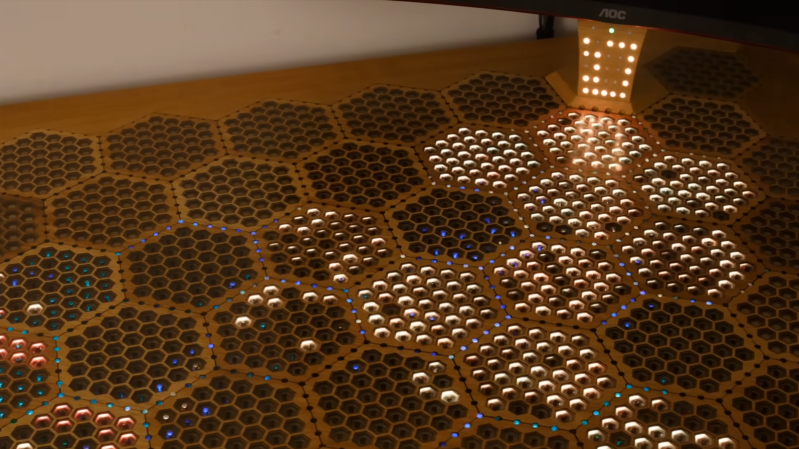Beehives are impressive structures, an example of the epic building feats that are achievable by nature’s smaller creatures. [Full Stack Woodworking] was recently building a new work desk, and decided to make this piece of furniture a glowing tribute to the glorious engineering of the bee. (Video, embedded below.)
The piece is a conventional L-shaped desk, but with a honeycomb motif inlaid into the surface itself. [Full Stack Woodworking] started by iterating on various designs with stacked hexagons made out of laser cut plywood and Perspex, filled with epoxy. Producing enough hexagons to populate the entire desk was no mean feat, requiring a great deal of cutting, staining, and gluing—and all this before the electronics even got involved! Naturally, each cell has a custom built PCB covered in addressable LEDs, and they’re linked with smaller linear PCBs which create “paths” for bees to move between cells.
What’s cool about the display is that it’s not just running some random RGB animations. Instead, the desk has a Raspberry Pi 5 dedicated to running a beehive simulation, where algorithmic rules determine the status (and thus color) of each hexagonal cell based on the behavior of virtual bees loading the cells with honey. It creates an organic, changing display in a way that’s rather reminiscent of Conway’s Game of Life.
It was a huge build, but the final result is impressive. We’ve featured some other great custom desks over the years too. Video after the break.
[Thanks to J. Peterson for the tip!]
















Very nice work! All that’s missing is a honey dispenser.
When I saw the headline, I envisioned a clear topped desk full of real bees with a tube letting them out a hole in the wall. This is somewhat less terrifying.
And more amazing at the same time!
Imagine a fully transparent, polycarbonate urinal which contains a small beehive. You could aim at bees and they’d think you’re shooting honey at them, except they can’t get at it. This is why CNC machines exist.
This is twisted, and I say so while laughing about the concept.
I’ll say, though, that if your urine comes out with a color and consistency that fools bees… you may be severely dehydrated. I would seek water and/or medical attention immediately to avoid kidney damage.
It’s both nice looking ..and would annoy the heck outta me .. I have loads of small things on my desk .. imagine it is be forever losing stuff through holes
Have you seen the video? The cells are filled with epoxy, so it’s a normal flat desk
This is simply epic. So cool to understand the complexities around how many operations each ‘machining step’ generates and how the thought process to ‘mass production’ comes together. Very rad project – love it.
Did they release their sourcecode anywhere? Just the simulation on it’s own is an interesting bit of programming that’d be fun to run and experiment with without the desk!
Mind-blowing that someone can have the vision, the skills, the equipment and THE UNBELIEVABLE STICK-AT-IT DEDICATION to create such an amazing thing that encompasses so many areas (bees, woodwork, electronics, programming) with 100% attention to detail and no shortcuts. As someone who struggles to finish anything, even badly, my hat goes off to you sir! Thank you for sharing.
Huh! Neat. I think I would’ve wired up the cells to visualize some relevant real-world data, rather than the simulation. (Which does have a cool factor, but one with a shelf life. It’s very cool, when you encounter it the first time… But then that’s it, it’s shot its wad and settles into being just sort of… “neat”.)
Something with practical utility could remain cool over time, for example: Server load, API request frequency, commit activity, or build progress.
The construction of the desk itself is extremely cool. Indefinitely.
(Yes, I ruin art by giving it a purpose.)
Re the headline, classy is not a positive adjective. This desk looks nice and doesn’t deserve to be guillotined in a proletarian revolution ;)